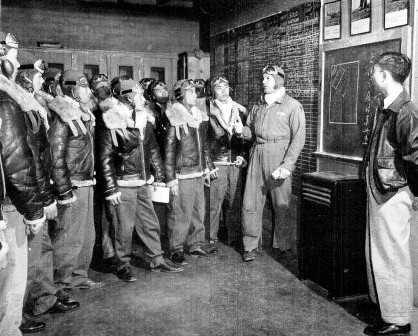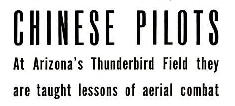Months before Dec. 7, the U.S. Army was training Chinese air cadets in this country.
These cadets, all officers in the Chinese Army, had received their general training under American tutelage at Hangchow.
After that flying school was bombed by the Japanese, they marched 1,000 weary miles to Chungking and then to Kunming.
From there they came to the U.S. and to Thunderbird Field, an air school owned by Leland Hayward which is now devoting its facilities to the Air Corps.
Two classes already have entered the school. How many more will follow them is a problem of wartime transportation.
Fledgling pilots of eleven of the United Nations are trained at Thunderbird and the Chinese are probably the smartest and most disciplined of the lot.
Language is their greatest barrier, for most of them speak different dialects, as foreign to their ears as English.
But with the use of a few basic phrases, interpreters and hand signals, they easily understand the instructors.
Flying is second nature to them and they waste no time in mastering its mysteries.
So eager are they to learn that they have finished the ten-week primary course in six weeks and advanced training at the Army's nearby Luke Field proportionately faster.
But life has not been all study for the Chinese cadets.
They are as fun-loving and mischievous as any American youths.
They have rapidly improved upon the Western custom of hazing and become so expert in volleyball and basketball that they have had a hard time getting American teams to play with them.
On March 27, the first class of 42 Chinese cadets graduated as pilots.
They were given their wings by Major General Teh-Hsieh Shen, the former chief of staff of the Chinese Air Force and now in charge of his country's training program in the U.S.
After the graduation ceremony, the new pilots lost little time in farewells.
Packing their bags, they started off the next morning, bound for China and the chance of putting their training into use against the airmen of Japan.
 Cadets in ready room are here given final instructions by O.E. Gates, Thunderbird flight commander, before going out to their planes.
Interpreter at right translates instructions into the various Chinese dialects spoken by cadets.
Hand signals are used by instructors in flight.
Chinese students rapidly learn key phrases in aviation slang.
Cadets in ready room are here given final instructions by O.E. Gates, Thunderbird flight commander, before going out to their planes.
Interpreter at right translates instructions into the various Chinese dialects spoken by cadets.
Hand signals are used by instructors in flight.
Chinese students rapidly learn key phrases in aviation slang.
|
 Final instruction before solo is given to Chao-Min Cheng by Instructor John Swope, former photographer and the son of Gerard Swope.
Final instruction before solo is given to Chao-Min Cheng by Instructor John Swope, former photographer and the son of Gerard Swope.
|
 First cadet to graduate, Shao-Hun Yang, is given wings by General Shen.
American and Chinese flags hang on wall of Luke Field auditorium where graduation took place.
First cadet to graduate, Shao-Hun Yang, is given wings by General Shen.
American and Chinese flags hang on wall of Luke Field auditorium where graduation took place.
|
 Chinese girls from nearby Phoenix congratulate newly graduated cadets.
Students lost little time in getting acquainted with Phoenix girls on arriving at Thunderbird.
Chinese girls from nearby Phoenix congratulate newly graduated cadets.
Students lost little time in getting acquainted with Phoenix girls on arriving at Thunderbird.
|

LIFE'S COVER: The serious young air cadet on the cover has covered a good bit of ground for his education.
A native of Canton, China, Chao-Min Cheng got some of his ground training at Hangchow.
When his school was bombed he and his fellow students went on foot to Chungking, then to Kunming, China.
From there, he came to Phoenix, Ariz. to complete his training at Thunderbird Field.
Cheng and his classmates have now been given their wings as lieutenants in the Chinese Air Corps and are on their way back to China to pay back the Japanese for their interrupted education.
 Cadets line up for inspection at 7:30 every morning.
They live in dormitories similar to those used by American student-pilots, study the same books, learn in same planes.
The cadet in foreground is Chao-Min Cheng of Canton.
His bright, alert face - also shown peering from the cockpit of his training plane on the cover - is typical of cadets.
Cadets line up for inspection at 7:30 every morning.
They live in dormitories similar to those used by American student-pilots, study the same books, learn in same planes.
The cadet in foreground is Chao-Min Cheng of Canton.
His bright, alert face - also shown peering from the cockpit of his training plane on the cover - is typical of cadets.
 Class in aerodynamics listens to instructor.
All explanations on blackboard are written in English and Chinese and announcements over school's loudspeaker system are given in both languages.
Chinese students are more attentive in classroom than any other nationality.
Below: students line up before Stearman trainers in early morning.
Class in aerodynamics listens to instructor.
All explanations on blackboard are written in English and Chinese and announcements over school's loudspeaker system are given in both languages.
Chinese students are more attentive in classroom than any other nationality.
Below: students line up before Stearman trainers in early morning.



 Cadets in ready room are here given final instructions by O.E. Gates, Thunderbird flight commander, before going out to their planes.
Interpreter at right translates instructions into the various Chinese dialects spoken by cadets.
Hand signals are used by instructors in flight.
Chinese students rapidly learn key phrases in aviation slang.
Cadets in ready room are here given final instructions by O.E. Gates, Thunderbird flight commander, before going out to their planes.
Interpreter at right translates instructions into the various Chinese dialects spoken by cadets.
Hand signals are used by instructors in flight.
Chinese students rapidly learn key phrases in aviation slang.
 Final instruction before solo is given to Chao-Min Cheng by Instructor John Swope, former photographer and the son of Gerard Swope.
Final instruction before solo is given to Chao-Min Cheng by Instructor John Swope, former photographer and the son of Gerard Swope.
 First cadet to graduate, Shao-Hun Yang, is given wings by General Shen.
American and Chinese flags hang on wall of Luke Field auditorium where graduation took place.
First cadet to graduate, Shao-Hun Yang, is given wings by General Shen.
American and Chinese flags hang on wall of Luke Field auditorium where graduation took place.
 Chinese girls from nearby Phoenix congratulate newly graduated cadets.
Students lost little time in getting acquainted with Phoenix girls on arriving at Thunderbird.
Chinese girls from nearby Phoenix congratulate newly graduated cadets.
Students lost little time in getting acquainted with Phoenix girls on arriving at Thunderbird.

